Developing a Business Strategy: Tesco's Competitive Advantage
VerifiedAdded on 2023/06/13
|16
|4437
|321
Report
AI Summary
This report provides a comprehensive analysis of Tesco's business strategy, utilizing various frameworks and models to assess its competitive position. It begins by examining the macro environment through PESTLE analysis, identifying political, economic, social, technological, environmental, and legal factors that influence Tesco's operations. The internal environment is then analyzed using SWOT and VRIO models to evaluate Tesco's strengths, weaknesses, opportunities, and threats, as well as its resources and capabilities. Porter's Five Forces model is applied to understand the competitive dynamics within the supermarket and retail sector. The report also explores suitable frameworks to enhance Tesco's competitive edge and devises a strategic management plan based on the analysis. Ultimately, the report interprets information applying competitive and environmental analysis to provide insights into Tesco's strategic challenges and opportunities.
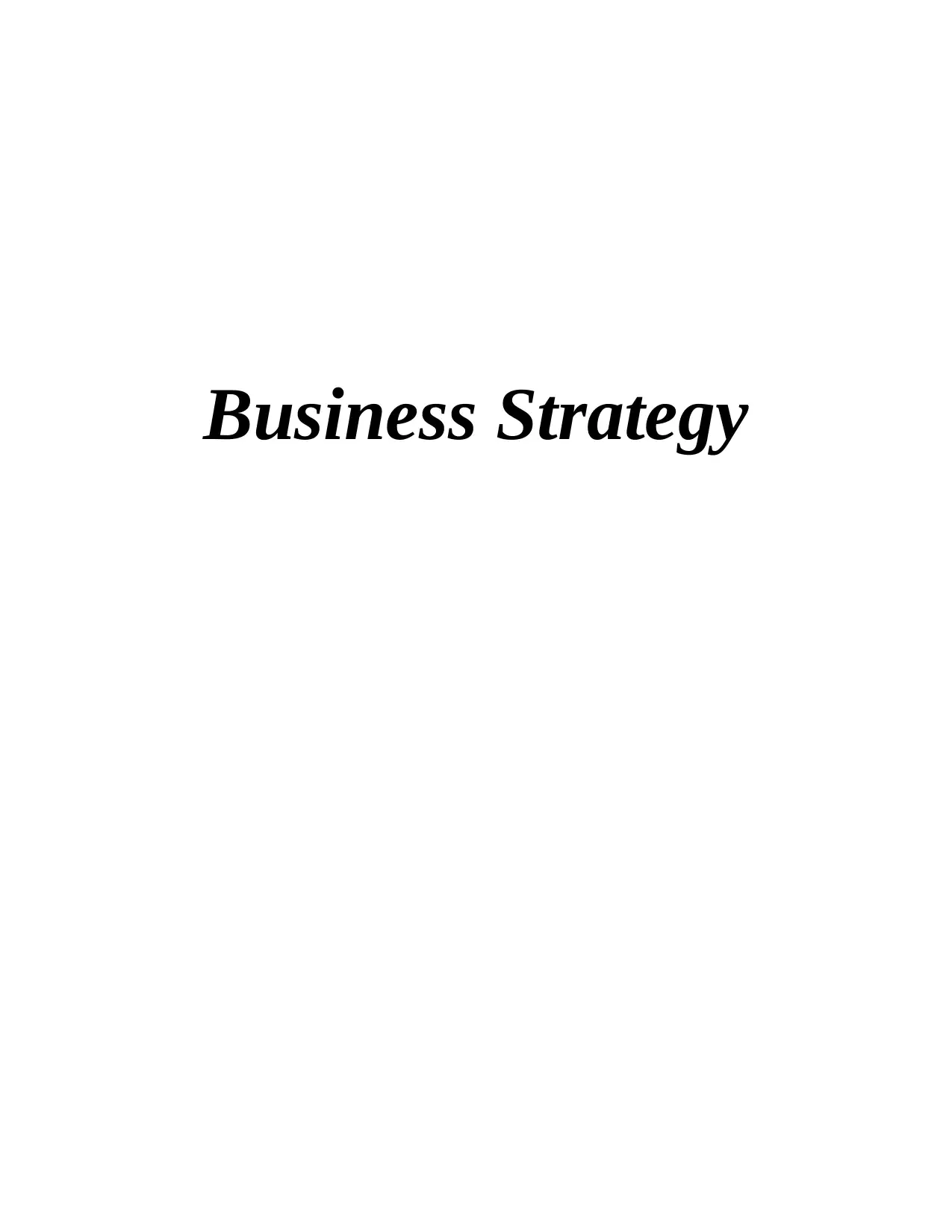
Business Strategy
Paraphrase This Document
Need a fresh take? Get an instant paraphrase of this document with our AI Paraphraser
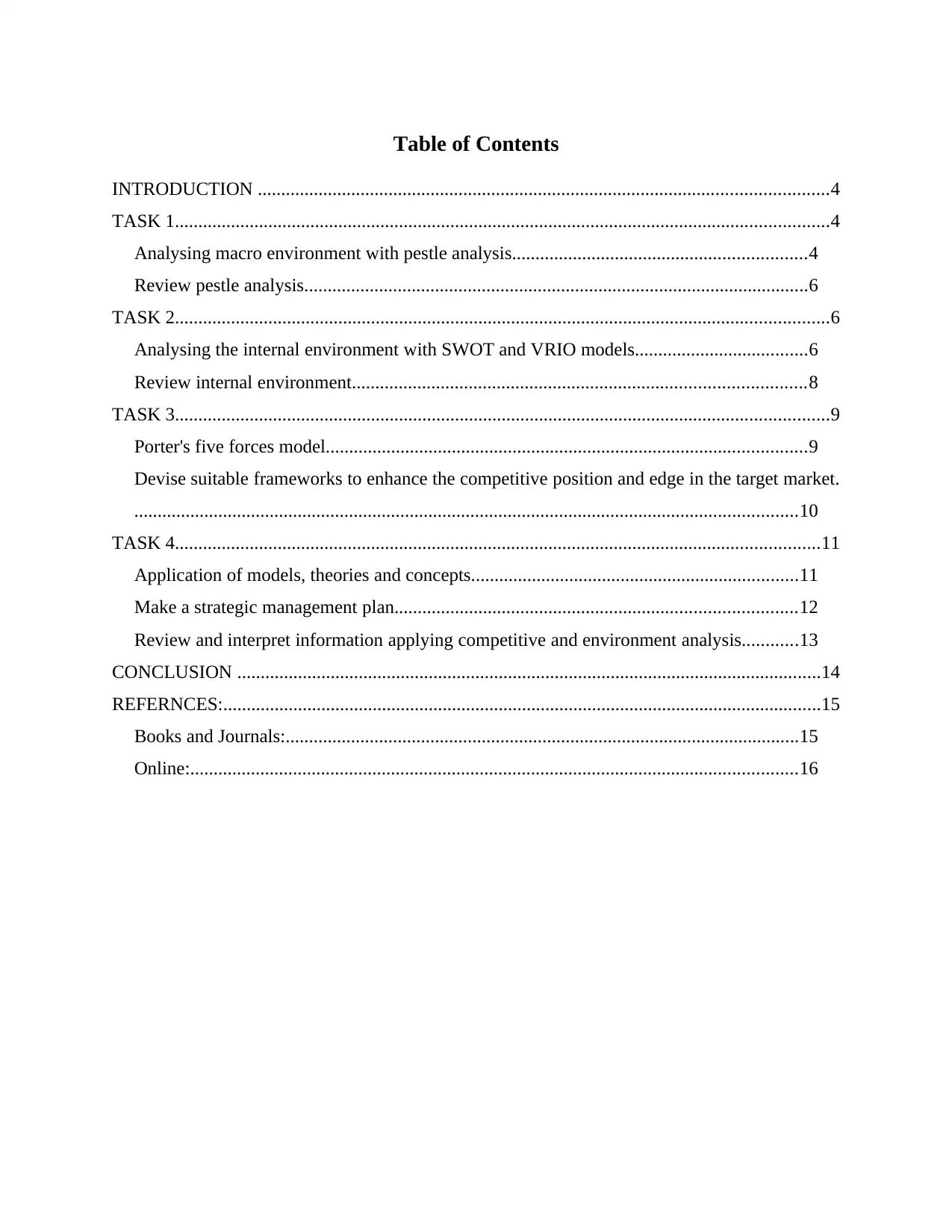
Table of Contents
INTRODUCTION ..........................................................................................................................4
TASK 1............................................................................................................................................4
Analysing macro environment with pestle analysis...............................................................4
Review pestle analysis............................................................................................................6
TASK 2............................................................................................................................................6
Analysing the internal environment with SWOT and VRIO models.....................................6
Review internal environment.................................................................................................8
TASK 3............................................................................................................................................9
Porter's five forces model.......................................................................................................9
Devise suitable frameworks to enhance the competitive position and edge in the target market.
..............................................................................................................................................10
TASK 4..........................................................................................................................................11
Application of models, theories and concepts......................................................................11
Make a strategic management plan......................................................................................12
Review and interpret information applying competitive and environment analysis............13
CONCLUSION .............................................................................................................................14
REFERNCES:................................................................................................................................15
Books and Journals:..............................................................................................................15
Online:..................................................................................................................................16
INTRODUCTION ..........................................................................................................................4
TASK 1............................................................................................................................................4
Analysing macro environment with pestle analysis...............................................................4
Review pestle analysis............................................................................................................6
TASK 2............................................................................................................................................6
Analysing the internal environment with SWOT and VRIO models.....................................6
Review internal environment.................................................................................................8
TASK 3............................................................................................................................................9
Porter's five forces model.......................................................................................................9
Devise suitable frameworks to enhance the competitive position and edge in the target market.
..............................................................................................................................................10
TASK 4..........................................................................................................................................11
Application of models, theories and concepts......................................................................11
Make a strategic management plan......................................................................................12
Review and interpret information applying competitive and environment analysis............13
CONCLUSION .............................................................................................................................14
REFERNCES:................................................................................................................................15
Books and Journals:..............................................................................................................15
Online:..................................................................................................................................16

⊘ This is a preview!⊘
Do you want full access?
Subscribe today to unlock all pages.

Trusted by 1+ million students worldwide
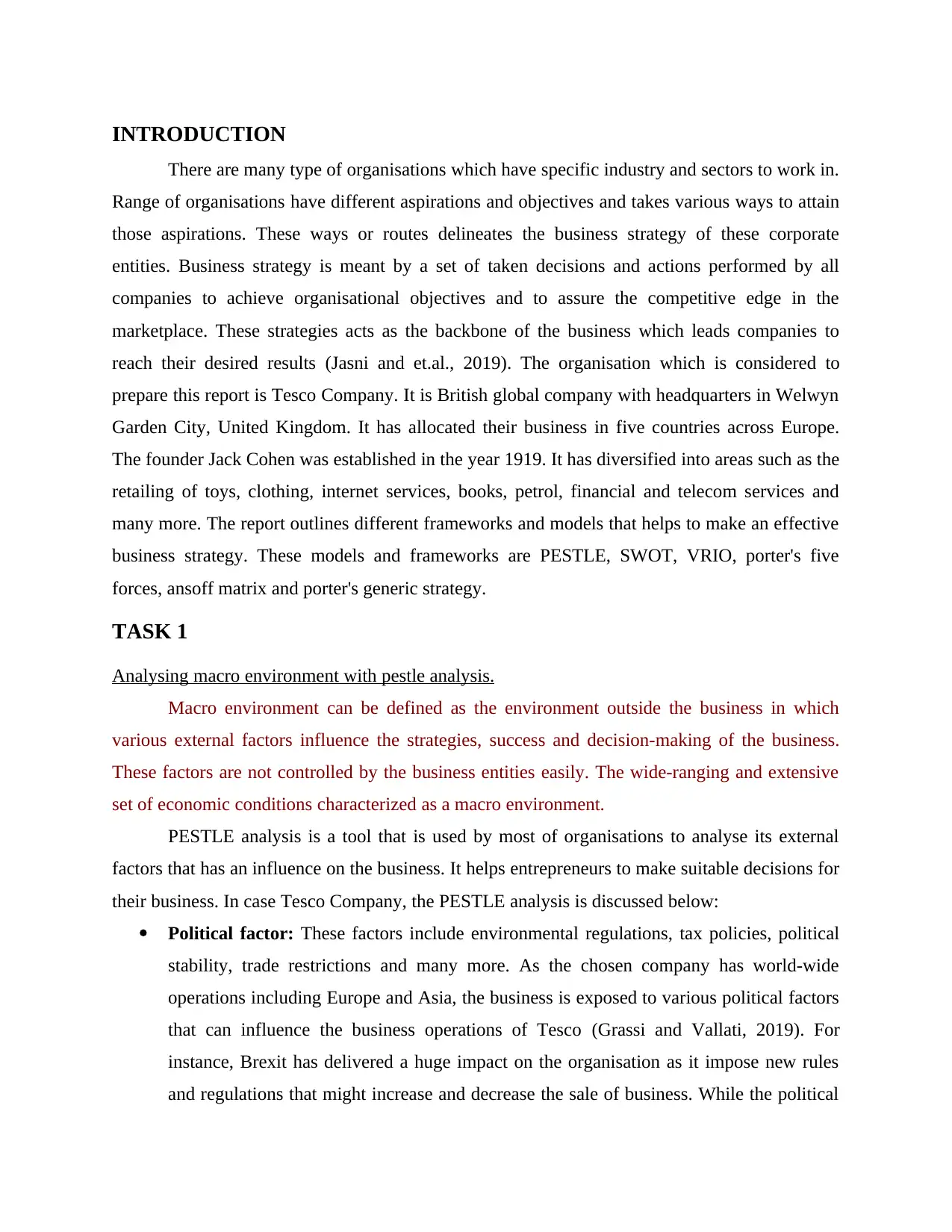
INTRODUCTION
There are many type of organisations which have specific industry and sectors to work in.
Range of organisations have different aspirations and objectives and takes various ways to attain
those aspirations. These ways or routes delineates the business strategy of these corporate
entities. Business strategy is meant by a set of taken decisions and actions performed by all
companies to achieve organisational objectives and to assure the competitive edge in the
marketplace. These strategies acts as the backbone of the business which leads companies to
reach their desired results (Jasni and et.al., 2019). The organisation which is considered to
prepare this report is Tesco Company. It is British global company with headquarters in Welwyn
Garden City, United Kingdom. It has allocated their business in five countries across Europe.
The founder Jack Cohen was established in the year 1919. It has diversified into areas such as the
retailing of toys, clothing, internet services, books, petrol, financial and telecom services and
many more. The report outlines different frameworks and models that helps to make an effective
business strategy. These models and frameworks are PESTLE, SWOT, VRIO, porter's five
forces, ansoff matrix and porter's generic strategy.
TASK 1
Analysing macro environment with pestle analysis.
Macro environment can be defined as the environment outside the business in which
various external factors influence the strategies, success and decision-making of the business.
These factors are not controlled by the business entities easily. The wide-ranging and extensive
set of economic conditions characterized as a macro environment.
PESTLE analysis is a tool that is used by most of organisations to analyse its external
factors that has an influence on the business. It helps entrepreneurs to make suitable decisions for
their business. In case Tesco Company, the PESTLE analysis is discussed below:
Political factor: These factors include environmental regulations, tax policies, political
stability, trade restrictions and many more. As the chosen company has world-wide
operations including Europe and Asia, the business is exposed to various political factors
that can influence the business operations of Tesco (Grassi and Vallati, 2019). For
instance, Brexit has delivered a huge impact on the organisation as it impose new rules
and regulations that might increase and decrease the sale of business. While the political
There are many type of organisations which have specific industry and sectors to work in.
Range of organisations have different aspirations and objectives and takes various ways to attain
those aspirations. These ways or routes delineates the business strategy of these corporate
entities. Business strategy is meant by a set of taken decisions and actions performed by all
companies to achieve organisational objectives and to assure the competitive edge in the
marketplace. These strategies acts as the backbone of the business which leads companies to
reach their desired results (Jasni and et.al., 2019). The organisation which is considered to
prepare this report is Tesco Company. It is British global company with headquarters in Welwyn
Garden City, United Kingdom. It has allocated their business in five countries across Europe.
The founder Jack Cohen was established in the year 1919. It has diversified into areas such as the
retailing of toys, clothing, internet services, books, petrol, financial and telecom services and
many more. The report outlines different frameworks and models that helps to make an effective
business strategy. These models and frameworks are PESTLE, SWOT, VRIO, porter's five
forces, ansoff matrix and porter's generic strategy.
TASK 1
Analysing macro environment with pestle analysis.
Macro environment can be defined as the environment outside the business in which
various external factors influence the strategies, success and decision-making of the business.
These factors are not controlled by the business entities easily. The wide-ranging and extensive
set of economic conditions characterized as a macro environment.
PESTLE analysis is a tool that is used by most of organisations to analyse its external
factors that has an influence on the business. It helps entrepreneurs to make suitable decisions for
their business. In case Tesco Company, the PESTLE analysis is discussed below:
Political factor: These factors include environmental regulations, tax policies, political
stability, trade restrictions and many more. As the chosen company has world-wide
operations including Europe and Asia, the business is exposed to various political factors
that can influence the business operations of Tesco (Grassi and Vallati, 2019). For
instance, Brexit has delivered a huge impact on the organisation as it impose new rules
and regulations that might increase and decrease the sale of business. While the political
Paraphrase This Document
Need a fresh take? Get an instant paraphrase of this document with our AI Paraphraser
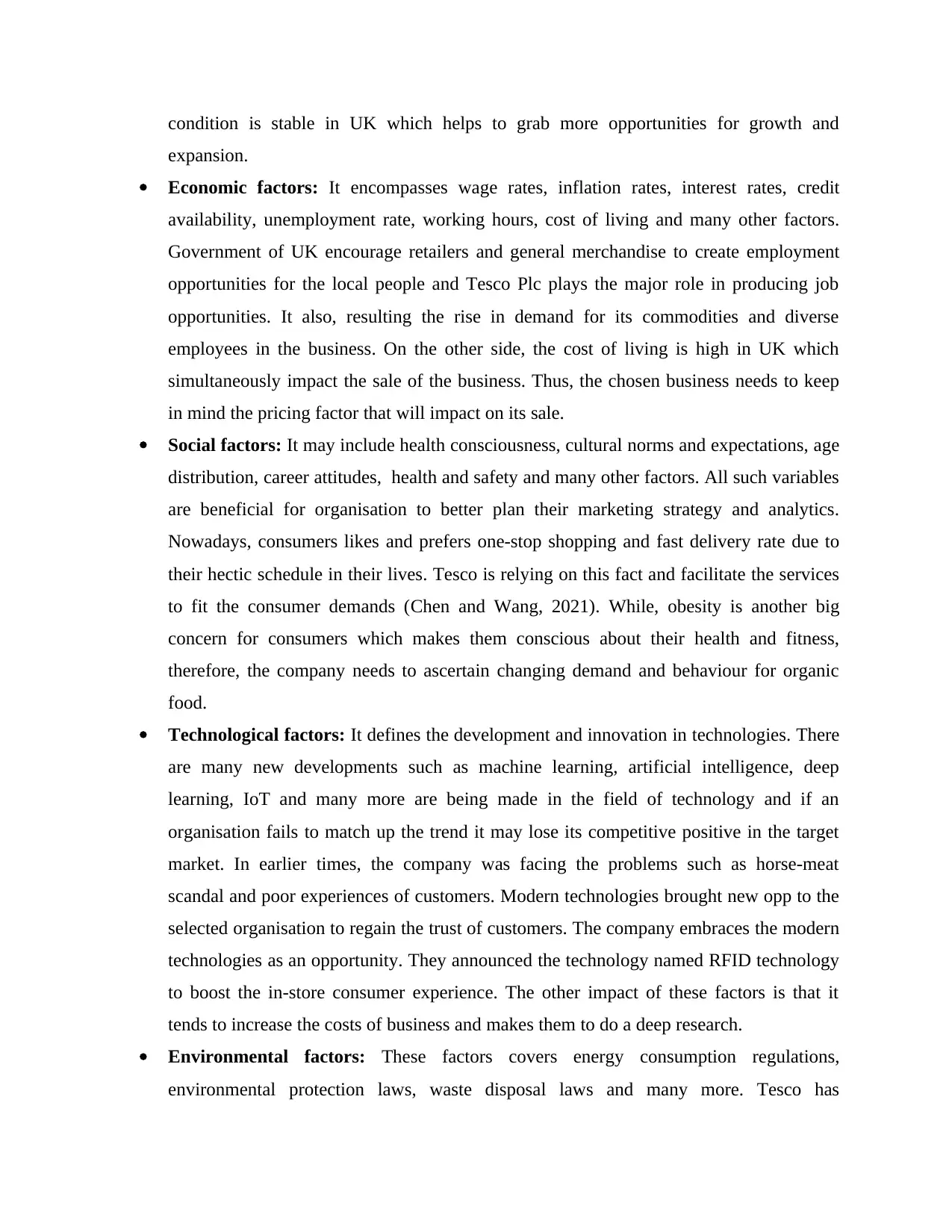
condition is stable in UK which helps to grab more opportunities for growth and
expansion.
Economic factors: It encompasses wage rates, inflation rates, interest rates, credit
availability, unemployment rate, working hours, cost of living and many other factors.
Government of UK encourage retailers and general merchandise to create employment
opportunities for the local people and Tesco Plc plays the major role in producing job
opportunities. It also, resulting the rise in demand for its commodities and diverse
employees in the business. On the other side, the cost of living is high in UK which
simultaneously impact the sale of the business. Thus, the chosen business needs to keep
in mind the pricing factor that will impact on its sale.
Social factors: It may include health consciousness, cultural norms and expectations, age
distribution, career attitudes, health and safety and many other factors. All such variables
are beneficial for organisation to better plan their marketing strategy and analytics.
Nowadays, consumers likes and prefers one-stop shopping and fast delivery rate due to
their hectic schedule in their lives. Tesco is relying on this fact and facilitate the services
to fit the consumer demands (Chen and Wang, 2021). While, obesity is another big
concern for consumers which makes them conscious about their health and fitness,
therefore, the company needs to ascertain changing demand and behaviour for organic
food.
Technological factors: It defines the development and innovation in technologies. There
are many new developments such as machine learning, artificial intelligence, deep
learning, IoT and many more are being made in the field of technology and if an
organisation fails to match up the trend it may lose its competitive positive in the target
market. In earlier times, the company was facing the problems such as horse-meat
scandal and poor experiences of customers. Modern technologies brought new opp to the
selected organisation to regain the trust of customers. The company embraces the modern
technologies as an opportunity. They announced the technology named RFID technology
to boost the in-store consumer experience. The other impact of these factors is that it
tends to increase the costs of business and makes them to do a deep research.
Environmental factors: These factors covers energy consumption regulations,
environmental protection laws, waste disposal laws and many more. Tesco has
expansion.
Economic factors: It encompasses wage rates, inflation rates, interest rates, credit
availability, unemployment rate, working hours, cost of living and many other factors.
Government of UK encourage retailers and general merchandise to create employment
opportunities for the local people and Tesco Plc plays the major role in producing job
opportunities. It also, resulting the rise in demand for its commodities and diverse
employees in the business. On the other side, the cost of living is high in UK which
simultaneously impact the sale of the business. Thus, the chosen business needs to keep
in mind the pricing factor that will impact on its sale.
Social factors: It may include health consciousness, cultural norms and expectations, age
distribution, career attitudes, health and safety and many other factors. All such variables
are beneficial for organisation to better plan their marketing strategy and analytics.
Nowadays, consumers likes and prefers one-stop shopping and fast delivery rate due to
their hectic schedule in their lives. Tesco is relying on this fact and facilitate the services
to fit the consumer demands (Chen and Wang, 2021). While, obesity is another big
concern for consumers which makes them conscious about their health and fitness,
therefore, the company needs to ascertain changing demand and behaviour for organic
food.
Technological factors: It defines the development and innovation in technologies. There
are many new developments such as machine learning, artificial intelligence, deep
learning, IoT and many more are being made in the field of technology and if an
organisation fails to match up the trend it may lose its competitive positive in the target
market. In earlier times, the company was facing the problems such as horse-meat
scandal and poor experiences of customers. Modern technologies brought new opp to the
selected organisation to regain the trust of customers. The company embraces the modern
technologies as an opportunity. They announced the technology named RFID technology
to boost the in-store consumer experience. The other impact of these factors is that it
tends to increase the costs of business and makes them to do a deep research.
Environmental factors: These factors covers energy consumption regulations,
environmental protection laws, waste disposal laws and many more. Tesco has
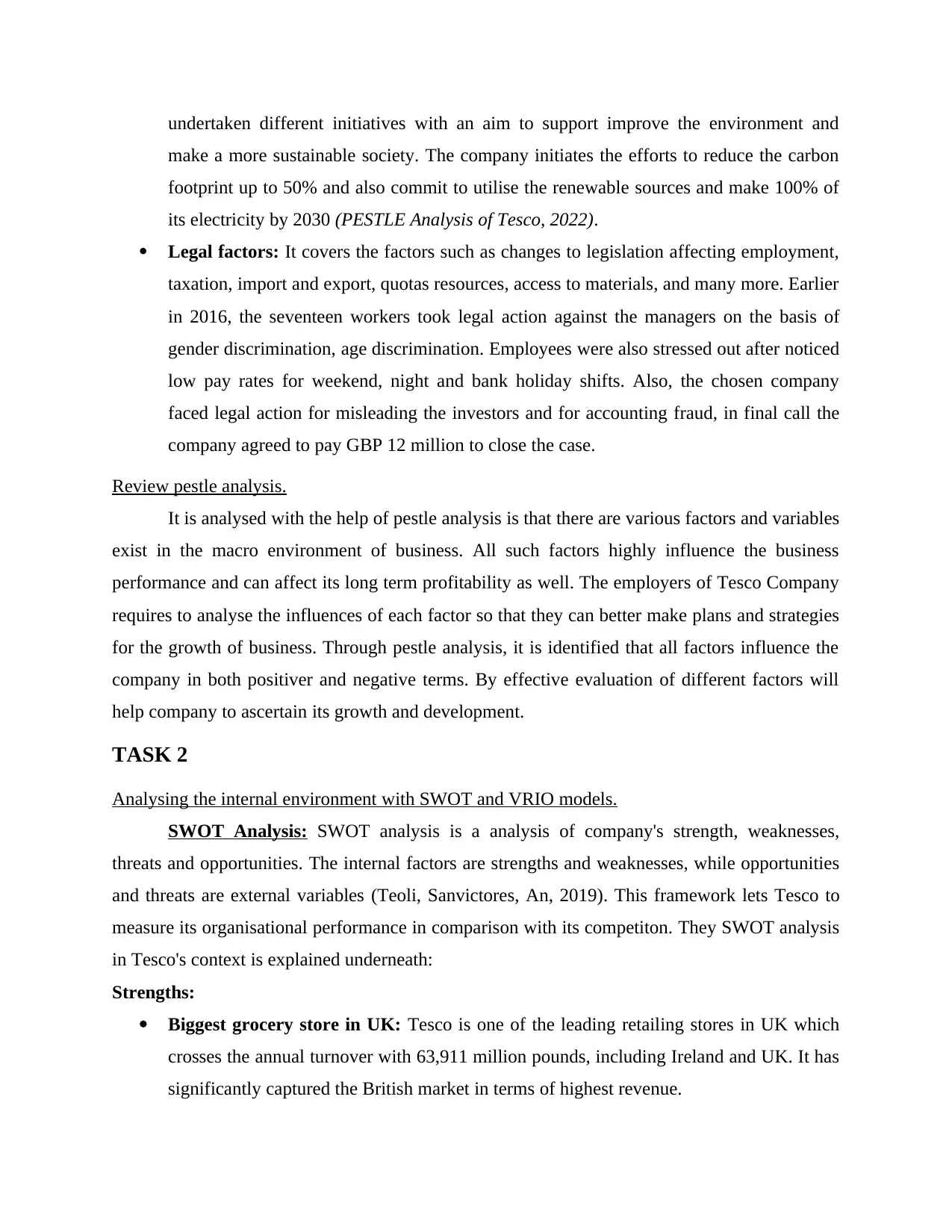
undertaken different initiatives with an aim to support improve the environment and
make a more sustainable society. The company initiates the efforts to reduce the carbon
footprint up to 50% and also commit to utilise the renewable sources and make 100% of
its electricity by 2030 (PESTLE Analysis of Tesco, 2022).
Legal factors: It covers the factors such as changes to legislation affecting employment,
taxation, import and export, quotas resources, access to materials, and many more. Earlier
in 2016, the seventeen workers took legal action against the managers on the basis of
gender discrimination, age discrimination. Employees were also stressed out after noticed
low pay rates for weekend, night and bank holiday shifts. Also, the chosen company
faced legal action for misleading the investors and for accounting fraud, in final call the
company agreed to pay GBP 12 million to close the case.
Review pestle analysis.
It is analysed with the help of pestle analysis is that there are various factors and variables
exist in the macro environment of business. All such factors highly influence the business
performance and can affect its long term profitability as well. The employers of Tesco Company
requires to analyse the influences of each factor so that they can better make plans and strategies
for the growth of business. Through pestle analysis, it is identified that all factors influence the
company in both positiver and negative terms. By effective evaluation of different factors will
help company to ascertain its growth and development.
TASK 2
Analysing the internal environment with SWOT and VRIO models.
SWOT Analysis: SWOT analysis is a analysis of company's strength, weaknesses,
threats and opportunities. The internal factors are strengths and weaknesses, while opportunities
and threats are external variables (Teoli, Sanvictores, An, 2019). This framework lets Tesco to
measure its organisational performance in comparison with its competiton. They SWOT analysis
in Tesco's context is explained underneath:
Strengths:
Biggest grocery store in UK: Tesco is one of the leading retailing stores in UK which
crosses the annual turnover with 63,911 million pounds, including Ireland and UK. It has
significantly captured the British market in terms of highest revenue.
make a more sustainable society. The company initiates the efforts to reduce the carbon
footprint up to 50% and also commit to utilise the renewable sources and make 100% of
its electricity by 2030 (PESTLE Analysis of Tesco, 2022).
Legal factors: It covers the factors such as changes to legislation affecting employment,
taxation, import and export, quotas resources, access to materials, and many more. Earlier
in 2016, the seventeen workers took legal action against the managers on the basis of
gender discrimination, age discrimination. Employees were also stressed out after noticed
low pay rates for weekend, night and bank holiday shifts. Also, the chosen company
faced legal action for misleading the investors and for accounting fraud, in final call the
company agreed to pay GBP 12 million to close the case.
Review pestle analysis.
It is analysed with the help of pestle analysis is that there are various factors and variables
exist in the macro environment of business. All such factors highly influence the business
performance and can affect its long term profitability as well. The employers of Tesco Company
requires to analyse the influences of each factor so that they can better make plans and strategies
for the growth of business. Through pestle analysis, it is identified that all factors influence the
company in both positiver and negative terms. By effective evaluation of different factors will
help company to ascertain its growth and development.
TASK 2
Analysing the internal environment with SWOT and VRIO models.
SWOT Analysis: SWOT analysis is a analysis of company's strength, weaknesses,
threats and opportunities. The internal factors are strengths and weaknesses, while opportunities
and threats are external variables (Teoli, Sanvictores, An, 2019). This framework lets Tesco to
measure its organisational performance in comparison with its competiton. They SWOT analysis
in Tesco's context is explained underneath:
Strengths:
Biggest grocery store in UK: Tesco is one of the leading retailing stores in UK which
crosses the annual turnover with 63,911 million pounds, including Ireland and UK. It has
significantly captured the British market in terms of highest revenue.
⊘ This is a preview!⊘
Do you want full access?
Subscribe today to unlock all pages.

Trusted by 1+ million students worldwide
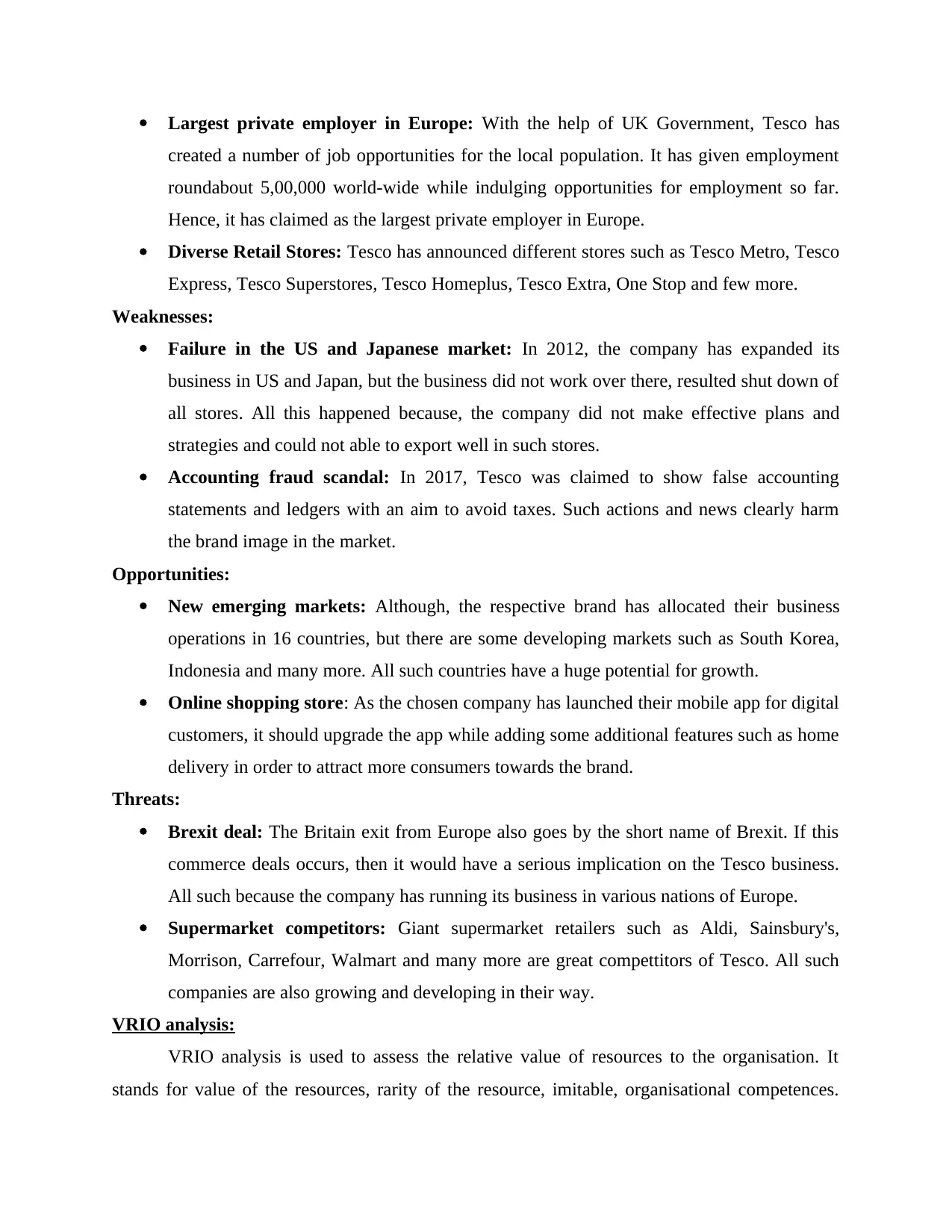
Largest private employer in Europe: With the help of UK Government, Tesco has
created a number of job opportunities for the local population. It has given employment
roundabout 5,00,000 world-wide while indulging opportunities for employment so far.
Hence, it has claimed as the largest private employer in Europe.
Diverse Retail Stores: Tesco has announced different stores such as Tesco Metro, Tesco
Express, Tesco Superstores, Tesco Homeplus, Tesco Extra, One Stop and few more.
Weaknesses:
Failure in the US and Japanese market: In 2012, the company has expanded its
business in US and Japan, but the business did not work over there, resulted shut down of
all stores. All this happened because, the company did not make effective plans and
strategies and could not able to export well in such stores.
Accounting fraud scandal: In 2017, Tesco was claimed to show false accounting
statements and ledgers with an aim to avoid taxes. Such actions and news clearly harm
the brand image in the market.
Opportunities:
New emerging markets: Although, the respective brand has allocated their business
operations in 16 countries, but there are some developing markets such as South Korea,
Indonesia and many more. All such countries have a huge potential for growth.
Online shopping store: As the chosen company has launched their mobile app for digital
customers, it should upgrade the app while adding some additional features such as home
delivery in order to attract more consumers towards the brand.
Threats:
Brexit deal: The Britain exit from Europe also goes by the short name of Brexit. If this
commerce deals occurs, then it would have a serious implication on the Tesco business.
All such because the company has running its business in various nations of Europe.
Supermarket competitors: Giant supermarket retailers such as Aldi, Sainsbury's,
Morrison, Carrefour, Walmart and many more are great compettitors of Tesco. All such
companies are also growing and developing in their way.
VRIO analysis:
VRIO analysis is used to assess the relative value of resources to the organisation. It
stands for value of the resources, rarity of the resource, imitable, organisational competences.
created a number of job opportunities for the local population. It has given employment
roundabout 5,00,000 world-wide while indulging opportunities for employment so far.
Hence, it has claimed as the largest private employer in Europe.
Diverse Retail Stores: Tesco has announced different stores such as Tesco Metro, Tesco
Express, Tesco Superstores, Tesco Homeplus, Tesco Extra, One Stop and few more.
Weaknesses:
Failure in the US and Japanese market: In 2012, the company has expanded its
business in US and Japan, but the business did not work over there, resulted shut down of
all stores. All this happened because, the company did not make effective plans and
strategies and could not able to export well in such stores.
Accounting fraud scandal: In 2017, Tesco was claimed to show false accounting
statements and ledgers with an aim to avoid taxes. Such actions and news clearly harm
the brand image in the market.
Opportunities:
New emerging markets: Although, the respective brand has allocated their business
operations in 16 countries, but there are some developing markets such as South Korea,
Indonesia and many more. All such countries have a huge potential for growth.
Online shopping store: As the chosen company has launched their mobile app for digital
customers, it should upgrade the app while adding some additional features such as home
delivery in order to attract more consumers towards the brand.
Threats:
Brexit deal: The Britain exit from Europe also goes by the short name of Brexit. If this
commerce deals occurs, then it would have a serious implication on the Tesco business.
All such because the company has running its business in various nations of Europe.
Supermarket competitors: Giant supermarket retailers such as Aldi, Sainsbury's,
Morrison, Carrefour, Walmart and many more are great compettitors of Tesco. All such
companies are also growing and developing in their way.
VRIO analysis:
VRIO analysis is used to assess the relative value of resources to the organisation. It
stands for value of the resources, rarity of the resource, imitable, organisational competences.
Paraphrase This Document
Need a fresh take? Get an instant paraphrase of this document with our AI Paraphraser
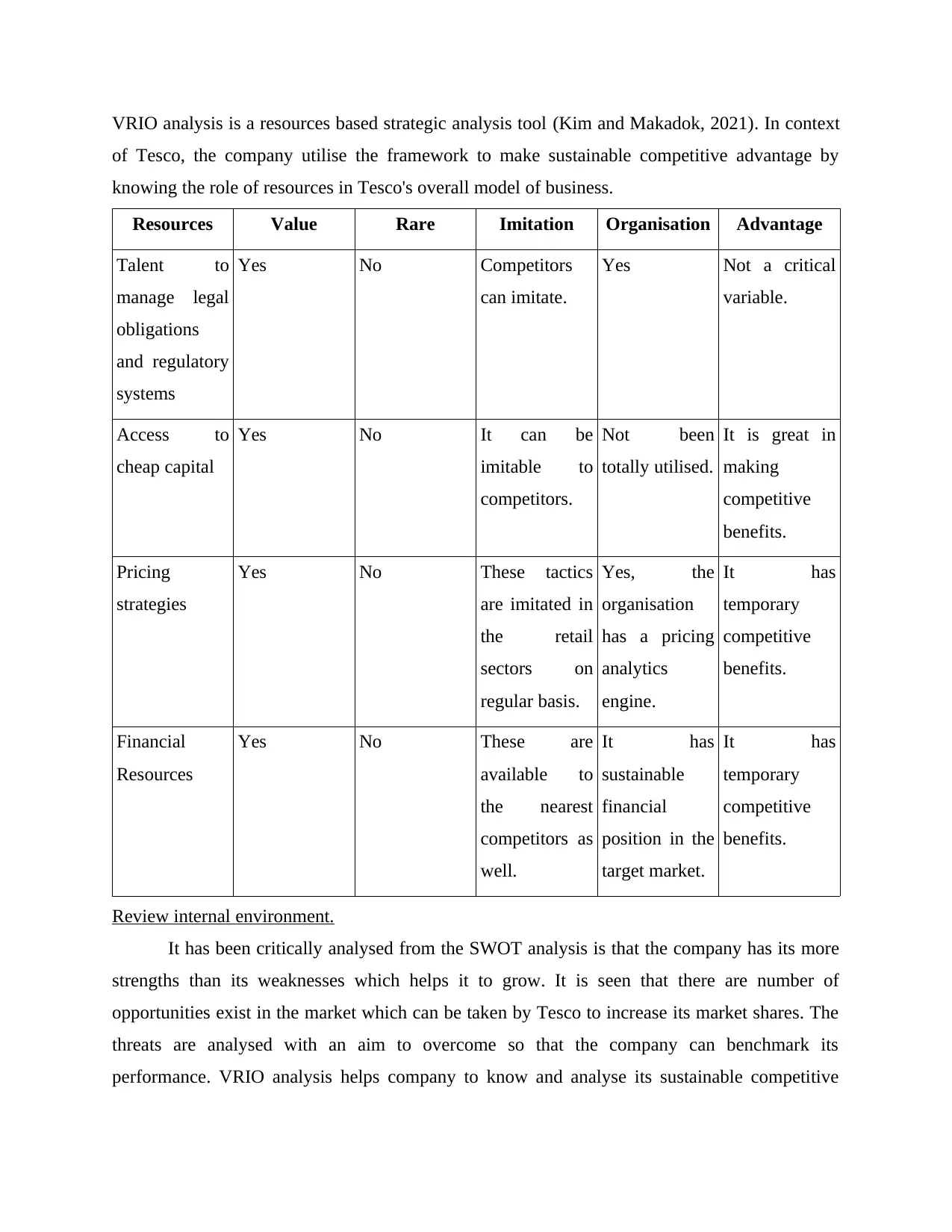
VRIO analysis is a resources based strategic analysis tool (Kim and Makadok, 2021). In context
of Tesco, the company utilise the framework to make sustainable competitive advantage by
knowing the role of resources in Tesco's overall model of business.
Resources Value Rare Imitation Organisation Advantage
Talent to
manage legal
obligations
and regulatory
systems
Yes No Competitors
can imitate.
Yes Not a critical
variable.
Access to
cheap capital
Yes No It can be
imitable to
competitors.
Not been
totally utilised.
It is great in
making
competitive
benefits.
Pricing
strategies
Yes No These tactics
are imitated in
the retail
sectors on
regular basis.
Yes, the
organisation
has a pricing
analytics
engine.
It has
temporary
competitive
benefits.
Financial
Resources
Yes No These are
available to
the nearest
competitors as
well.
It has
sustainable
financial
position in the
target market.
It has
temporary
competitive
benefits.
Review internal environment.
It has been critically analysed from the SWOT analysis is that the company has its more
strengths than its weaknesses which helps it to grow. It is seen that there are number of
opportunities exist in the market which can be taken by Tesco to increase its market shares. The
threats are analysed with an aim to overcome so that the company can benchmark its
performance. VRIO analysis helps company to know and analyse its sustainable competitive
of Tesco, the company utilise the framework to make sustainable competitive advantage by
knowing the role of resources in Tesco's overall model of business.
Resources Value Rare Imitation Organisation Advantage
Talent to
manage legal
obligations
and regulatory
systems
Yes No Competitors
can imitate.
Yes Not a critical
variable.
Access to
cheap capital
Yes No It can be
imitable to
competitors.
Not been
totally utilised.
It is great in
making
competitive
benefits.
Pricing
strategies
Yes No These tactics
are imitated in
the retail
sectors on
regular basis.
Yes, the
organisation
has a pricing
analytics
engine.
It has
temporary
competitive
benefits.
Financial
Resources
Yes No These are
available to
the nearest
competitors as
well.
It has
sustainable
financial
position in the
target market.
It has
temporary
competitive
benefits.
Review internal environment.
It has been critically analysed from the SWOT analysis is that the company has its more
strengths than its weaknesses which helps it to grow. It is seen that there are number of
opportunities exist in the market which can be taken by Tesco to increase its market shares. The
threats are analysed with an aim to overcome so that the company can benchmark its
performance. VRIO analysis helps company to know and analyse its sustainable competitive
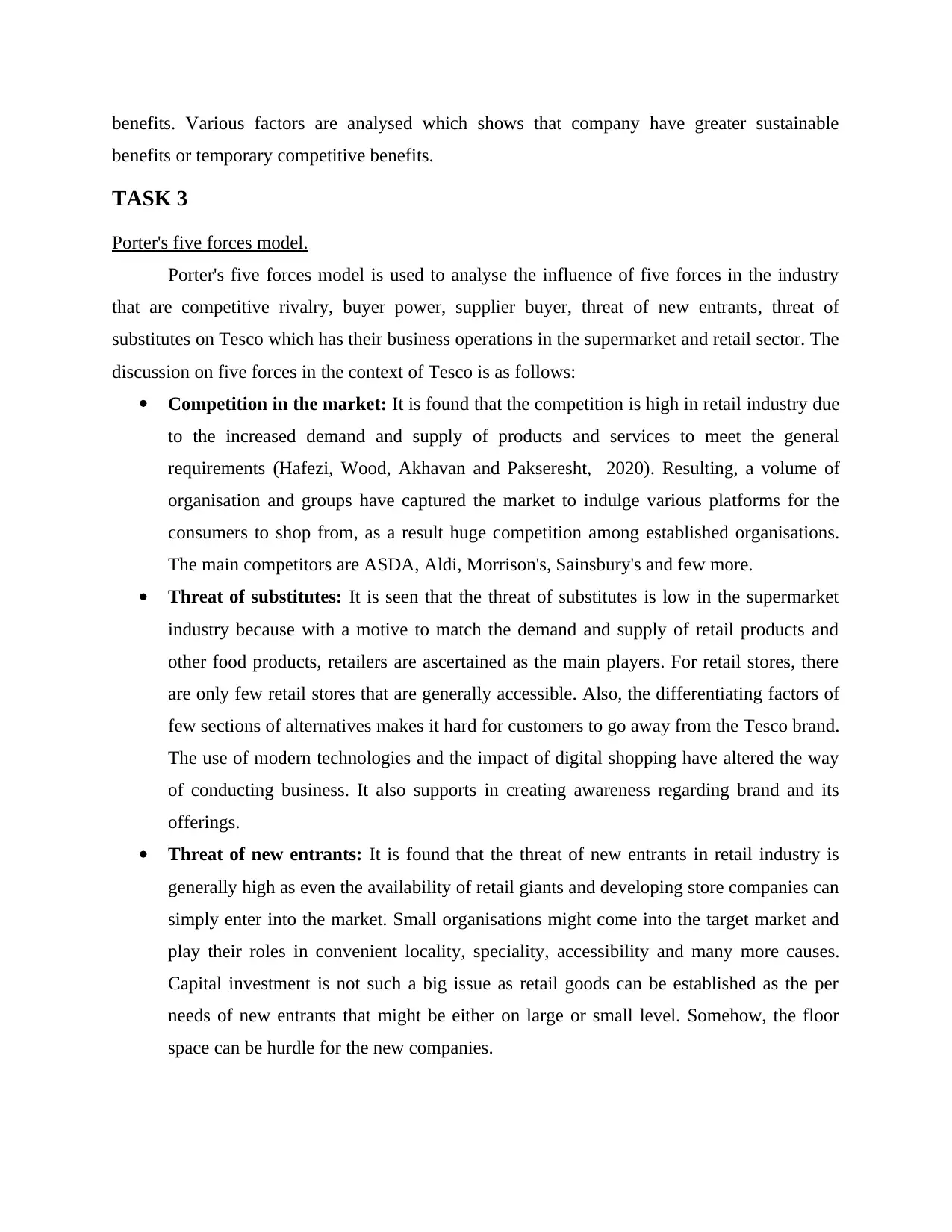
benefits. Various factors are analysed which shows that company have greater sustainable
benefits or temporary competitive benefits.
TASK 3
Porter's five forces model.
Porter's five forces model is used to analyse the influence of five forces in the industry
that are competitive rivalry, buyer power, supplier buyer, threat of new entrants, threat of
substitutes on Tesco which has their business operations in the supermarket and retail sector. The
discussion on five forces in the context of Tesco is as follows:
Competition in the market: It is found that the competition is high in retail industry due
to the increased demand and supply of products and services to meet the general
requirements (Hafezi, Wood, Akhavan and Pakseresht, 2020). Resulting, a volume of
organisation and groups have captured the market to indulge various platforms for the
consumers to shop from, as a result huge competition among established organisations.
The main competitors are ASDA, Aldi, Morrison's, Sainsbury's and few more.
Threat of substitutes: It is seen that the threat of substitutes is low in the supermarket
industry because with a motive to match the demand and supply of retail products and
other food products, retailers are ascertained as the main players. For retail stores, there
are only few retail stores that are generally accessible. Also, the differentiating factors of
few sections of alternatives makes it hard for customers to go away from the Tesco brand.
The use of modern technologies and the impact of digital shopping have altered the way
of conducting business. It also supports in creating awareness regarding brand and its
offerings.
Threat of new entrants: It is found that the threat of new entrants in retail industry is
generally high as even the availability of retail giants and developing store companies can
simply enter into the market. Small organisations might come into the target market and
play their roles in convenient locality, speciality, accessibility and many more causes.
Capital investment is not such a big issue as retail goods can be established as the per
needs of new entrants that might be either on large or small level. Somehow, the floor
space can be hurdle for the new companies.
benefits or temporary competitive benefits.
TASK 3
Porter's five forces model.
Porter's five forces model is used to analyse the influence of five forces in the industry
that are competitive rivalry, buyer power, supplier buyer, threat of new entrants, threat of
substitutes on Tesco which has their business operations in the supermarket and retail sector. The
discussion on five forces in the context of Tesco is as follows:
Competition in the market: It is found that the competition is high in retail industry due
to the increased demand and supply of products and services to meet the general
requirements (Hafezi, Wood, Akhavan and Pakseresht, 2020). Resulting, a volume of
organisation and groups have captured the market to indulge various platforms for the
consumers to shop from, as a result huge competition among established organisations.
The main competitors are ASDA, Aldi, Morrison's, Sainsbury's and few more.
Threat of substitutes: It is seen that the threat of substitutes is low in the supermarket
industry because with a motive to match the demand and supply of retail products and
other food products, retailers are ascertained as the main players. For retail stores, there
are only few retail stores that are generally accessible. Also, the differentiating factors of
few sections of alternatives makes it hard for customers to go away from the Tesco brand.
The use of modern technologies and the impact of digital shopping have altered the way
of conducting business. It also supports in creating awareness regarding brand and its
offerings.
Threat of new entrants: It is found that the threat of new entrants in retail industry is
generally high as even the availability of retail giants and developing store companies can
simply enter into the market. Small organisations might come into the target market and
play their roles in convenient locality, speciality, accessibility and many more causes.
Capital investment is not such a big issue as retail goods can be established as the per
needs of new entrants that might be either on large or small level. Somehow, the floor
space can be hurdle for the new companies.
⊘ This is a preview!⊘
Do you want full access?
Subscribe today to unlock all pages.

Trusted by 1+ million students worldwide
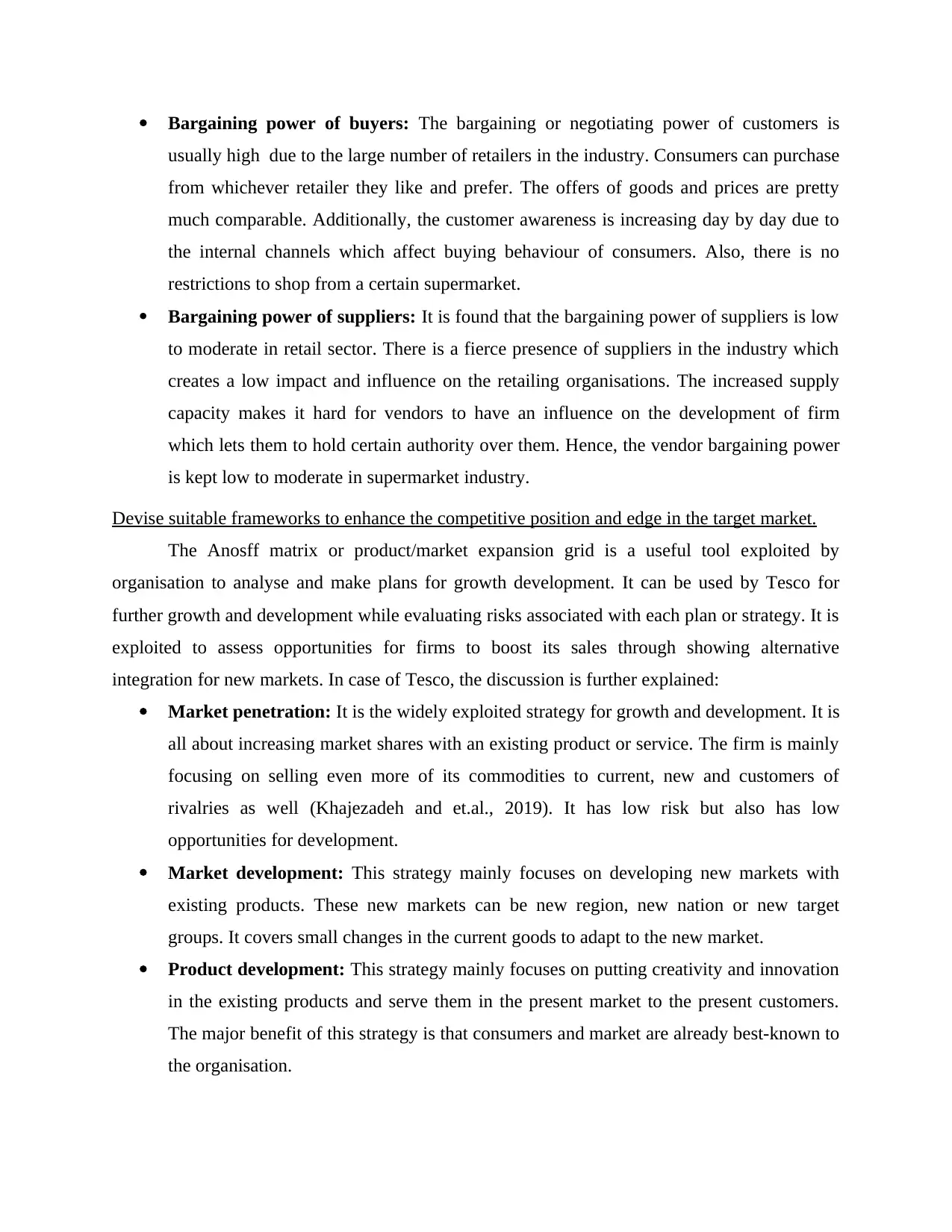
Bargaining power of buyers: The bargaining or negotiating power of customers is
usually high due to the large number of retailers in the industry. Consumers can purchase
from whichever retailer they like and prefer. The offers of goods and prices are pretty
much comparable. Additionally, the customer awareness is increasing day by day due to
the internal channels which affect buying behaviour of consumers. Also, there is no
restrictions to shop from a certain supermarket.
Bargaining power of suppliers: It is found that the bargaining power of suppliers is low
to moderate in retail sector. There is a fierce presence of suppliers in the industry which
creates a low impact and influence on the retailing organisations. The increased supply
capacity makes it hard for vendors to have an influence on the development of firm
which lets them to hold certain authority over them. Hence, the vendor bargaining power
is kept low to moderate in supermarket industry.
Devise suitable frameworks to enhance the competitive position and edge in the target market.
The Anosff matrix or product/market expansion grid is a useful tool exploited by
organisation to analyse and make plans for growth development. It can be used by Tesco for
further growth and development while evaluating risks associated with each plan or strategy. It is
exploited to assess opportunities for firms to boost its sales through showing alternative
integration for new markets. In case of Tesco, the discussion is further explained:
Market penetration: It is the widely exploited strategy for growth and development. It is
all about increasing market shares with an existing product or service. The firm is mainly
focusing on selling even more of its commodities to current, new and customers of
rivalries as well (Khajezadeh and et.al., 2019). It has low risk but also has low
opportunities for development.
Market development: This strategy mainly focuses on developing new markets with
existing products. These new markets can be new region, new nation or new target
groups. It covers small changes in the current goods to adapt to the new market.
Product development: This strategy mainly focuses on putting creativity and innovation
in the existing products and serve them in the present market to the present customers.
The major benefit of this strategy is that consumers and market are already best-known to
the organisation.
usually high due to the large number of retailers in the industry. Consumers can purchase
from whichever retailer they like and prefer. The offers of goods and prices are pretty
much comparable. Additionally, the customer awareness is increasing day by day due to
the internal channels which affect buying behaviour of consumers. Also, there is no
restrictions to shop from a certain supermarket.
Bargaining power of suppliers: It is found that the bargaining power of suppliers is low
to moderate in retail sector. There is a fierce presence of suppliers in the industry which
creates a low impact and influence on the retailing organisations. The increased supply
capacity makes it hard for vendors to have an influence on the development of firm
which lets them to hold certain authority over them. Hence, the vendor bargaining power
is kept low to moderate in supermarket industry.
Devise suitable frameworks to enhance the competitive position and edge in the target market.
The Anosff matrix or product/market expansion grid is a useful tool exploited by
organisation to analyse and make plans for growth development. It can be used by Tesco for
further growth and development while evaluating risks associated with each plan or strategy. It is
exploited to assess opportunities for firms to boost its sales through showing alternative
integration for new markets. In case of Tesco, the discussion is further explained:
Market penetration: It is the widely exploited strategy for growth and development. It is
all about increasing market shares with an existing product or service. The firm is mainly
focusing on selling even more of its commodities to current, new and customers of
rivalries as well (Khajezadeh and et.al., 2019). It has low risk but also has low
opportunities for development.
Market development: This strategy mainly focuses on developing new markets with
existing products. These new markets can be new region, new nation or new target
groups. It covers small changes in the current goods to adapt to the new market.
Product development: This strategy mainly focuses on putting creativity and innovation
in the existing products and serve them in the present market to the present customers.
The major benefit of this strategy is that consumers and market are already best-known to
the organisation.
Paraphrase This Document
Need a fresh take? Get an instant paraphrase of this document with our AI Paraphraser
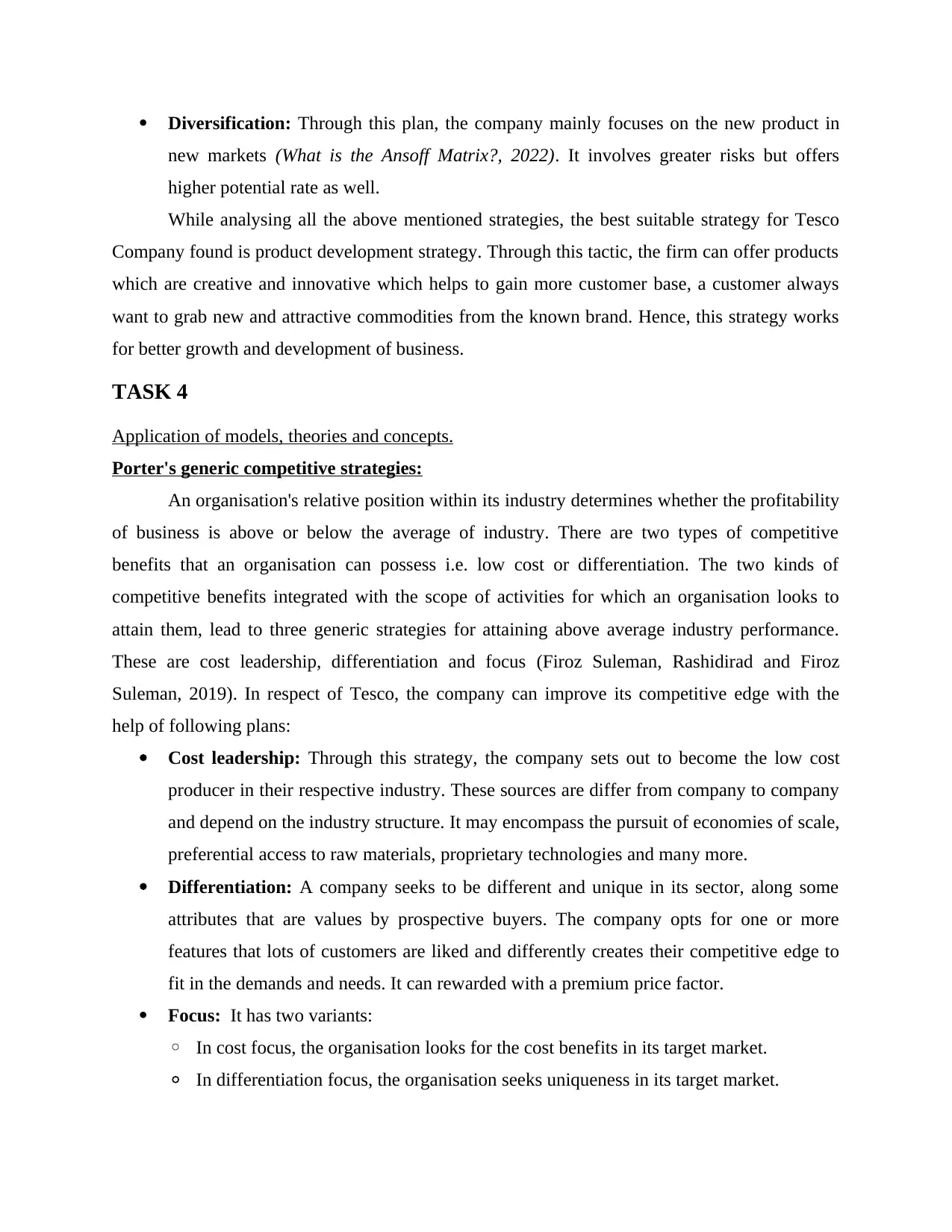
Diversification: Through this plan, the company mainly focuses on the new product in
new markets (What is the Ansoff Matrix?, 2022). It involves greater risks but offers
higher potential rate as well.
While analysing all the above mentioned strategies, the best suitable strategy for Tesco
Company found is product development strategy. Through this tactic, the firm can offer products
which are creative and innovative which helps to gain more customer base, a customer always
want to grab new and attractive commodities from the known brand. Hence, this strategy works
for better growth and development of business.
TASK 4
Application of models, theories and concepts.
Porter's generic competitive strategies:
An organisation's relative position within its industry determines whether the profitability
of business is above or below the average of industry. There are two types of competitive
benefits that an organisation can possess i.e. low cost or differentiation. The two kinds of
competitive benefits integrated with the scope of activities for which an organisation looks to
attain them, lead to three generic strategies for attaining above average industry performance.
These are cost leadership, differentiation and focus (Firoz Suleman, Rashidirad and Firoz
Suleman, 2019). In respect of Tesco, the company can improve its competitive edge with the
help of following plans:
Cost leadership: Through this strategy, the company sets out to become the low cost
producer in their respective industry. These sources are differ from company to company
and depend on the industry structure. It may encompass the pursuit of economies of scale,
preferential access to raw materials, proprietary technologies and many more.
Differentiation: A company seeks to be different and unique in its sector, along some
attributes that are values by prospective buyers. The company opts for one or more
features that lots of customers are liked and differently creates their competitive edge to
fit in the demands and needs. It can rewarded with a premium price factor.
Focus: It has two variants:
◦ In cost focus, the organisation looks for the cost benefits in its target market.
◦ In differentiation focus, the organisation seeks uniqueness in its target market.
new markets (What is the Ansoff Matrix?, 2022). It involves greater risks but offers
higher potential rate as well.
While analysing all the above mentioned strategies, the best suitable strategy for Tesco
Company found is product development strategy. Through this tactic, the firm can offer products
which are creative and innovative which helps to gain more customer base, a customer always
want to grab new and attractive commodities from the known brand. Hence, this strategy works
for better growth and development of business.
TASK 4
Application of models, theories and concepts.
Porter's generic competitive strategies:
An organisation's relative position within its industry determines whether the profitability
of business is above or below the average of industry. There are two types of competitive
benefits that an organisation can possess i.e. low cost or differentiation. The two kinds of
competitive benefits integrated with the scope of activities for which an organisation looks to
attain them, lead to three generic strategies for attaining above average industry performance.
These are cost leadership, differentiation and focus (Firoz Suleman, Rashidirad and Firoz
Suleman, 2019). In respect of Tesco, the company can improve its competitive edge with the
help of following plans:
Cost leadership: Through this strategy, the company sets out to become the low cost
producer in their respective industry. These sources are differ from company to company
and depend on the industry structure. It may encompass the pursuit of economies of scale,
preferential access to raw materials, proprietary technologies and many more.
Differentiation: A company seeks to be different and unique in its sector, along some
attributes that are values by prospective buyers. The company opts for one or more
features that lots of customers are liked and differently creates their competitive edge to
fit in the demands and needs. It can rewarded with a premium price factor.
Focus: It has two variants:
◦ In cost focus, the organisation looks for the cost benefits in its target market.
◦ In differentiation focus, the organisation seeks uniqueness in its target market.
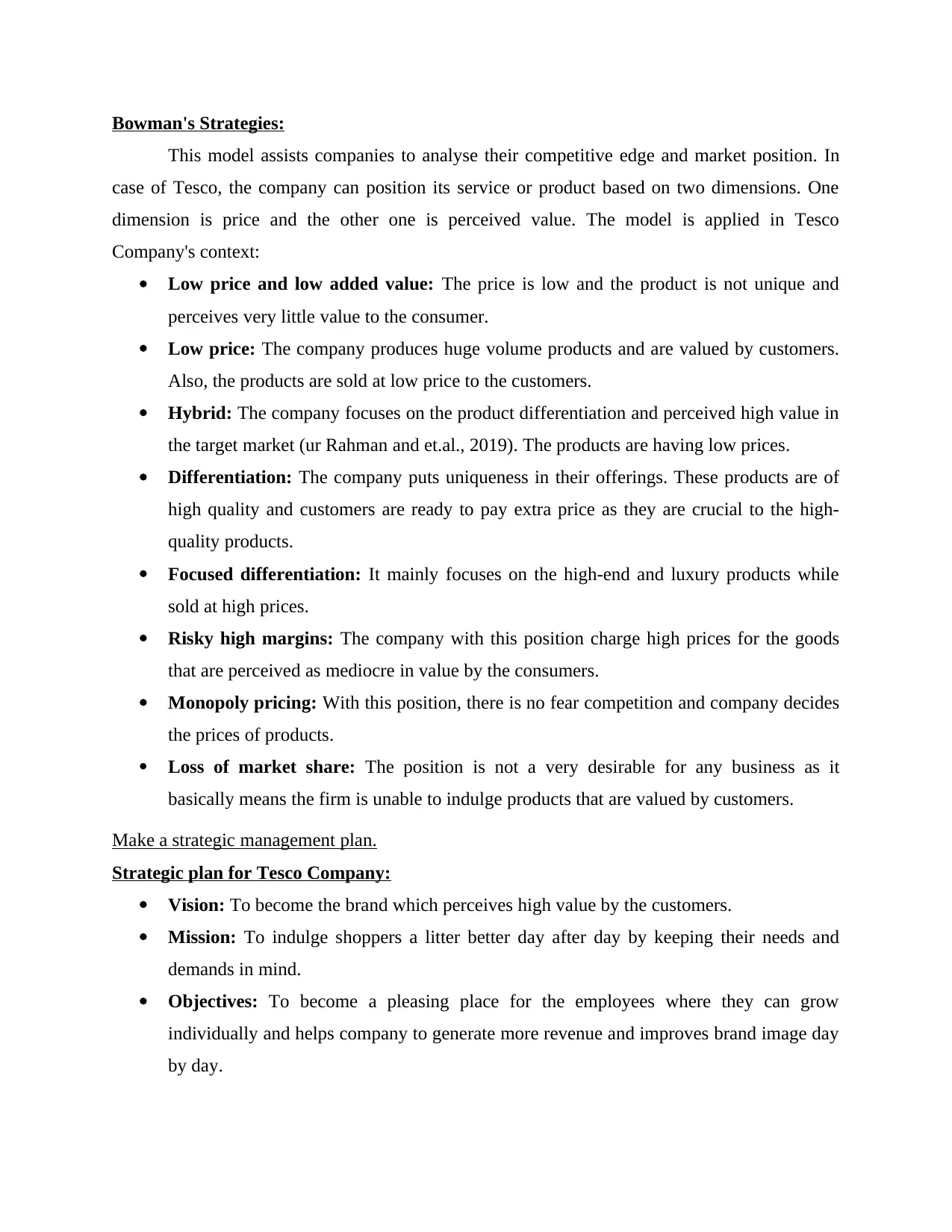
Bowman's Strategies:
This model assists companies to analyse their competitive edge and market position. In
case of Tesco, the company can position its service or product based on two dimensions. One
dimension is price and the other one is perceived value. The model is applied in Tesco
Company's context:
Low price and low added value: The price is low and the product is not unique and
perceives very little value to the consumer.
Low price: The company produces huge volume products and are valued by customers.
Also, the products are sold at low price to the customers.
Hybrid: The company focuses on the product differentiation and perceived high value in
the target market (ur Rahman and et.al., 2019). The products are having low prices.
Differentiation: The company puts uniqueness in their offerings. These products are of
high quality and customers are ready to pay extra price as they are crucial to the high-
quality products.
Focused differentiation: It mainly focuses on the high-end and luxury products while
sold at high prices.
Risky high margins: The company with this position charge high prices for the goods
that are perceived as mediocre in value by the consumers.
Monopoly pricing: With this position, there is no fear competition and company decides
the prices of products.
Loss of market share: The position is not a very desirable for any business as it
basically means the firm is unable to indulge products that are valued by customers.
Make a strategic management plan.
Strategic plan for Tesco Company:
Vision: To become the brand which perceives high value by the customers.
Mission: To indulge shoppers a litter better day after day by keeping their needs and
demands in mind.
Objectives: To become a pleasing place for the employees where they can grow
individually and helps company to generate more revenue and improves brand image day
by day.
This model assists companies to analyse their competitive edge and market position. In
case of Tesco, the company can position its service or product based on two dimensions. One
dimension is price and the other one is perceived value. The model is applied in Tesco
Company's context:
Low price and low added value: The price is low and the product is not unique and
perceives very little value to the consumer.
Low price: The company produces huge volume products and are valued by customers.
Also, the products are sold at low price to the customers.
Hybrid: The company focuses on the product differentiation and perceived high value in
the target market (ur Rahman and et.al., 2019). The products are having low prices.
Differentiation: The company puts uniqueness in their offerings. These products are of
high quality and customers are ready to pay extra price as they are crucial to the high-
quality products.
Focused differentiation: It mainly focuses on the high-end and luxury products while
sold at high prices.
Risky high margins: The company with this position charge high prices for the goods
that are perceived as mediocre in value by the consumers.
Monopoly pricing: With this position, there is no fear competition and company decides
the prices of products.
Loss of market share: The position is not a very desirable for any business as it
basically means the firm is unable to indulge products that are valued by customers.
Make a strategic management plan.
Strategic plan for Tesco Company:
Vision: To become the brand which perceives high value by the customers.
Mission: To indulge shoppers a litter better day after day by keeping their needs and
demands in mind.
Objectives: To become a pleasing place for the employees where they can grow
individually and helps company to generate more revenue and improves brand image day
by day.
⊘ This is a preview!⊘
Do you want full access?
Subscribe today to unlock all pages.

Trusted by 1+ million students worldwide
1 out of 16
Related Documents
Your All-in-One AI-Powered Toolkit for Academic Success.
+13062052269
info@desklib.com
Available 24*7 on WhatsApp / Email
![[object Object]](/_next/static/media/star-bottom.7253800d.svg)
Unlock your academic potential
Copyright © 2020–2025 A2Z Services. All Rights Reserved. Developed and managed by ZUCOL.




